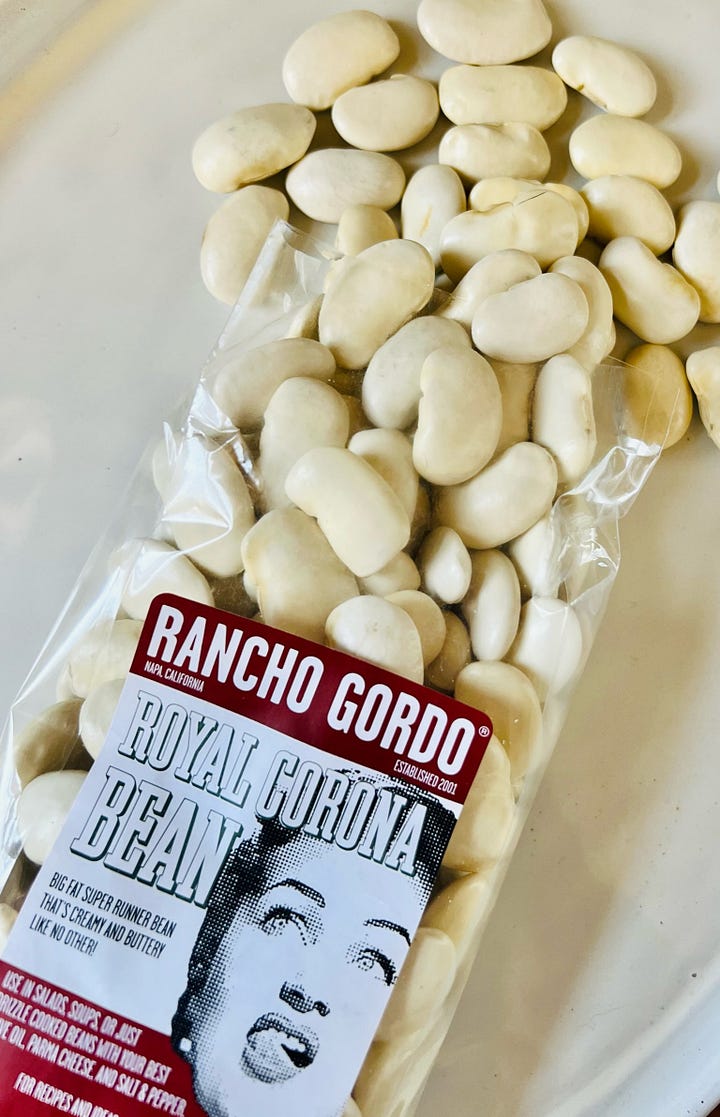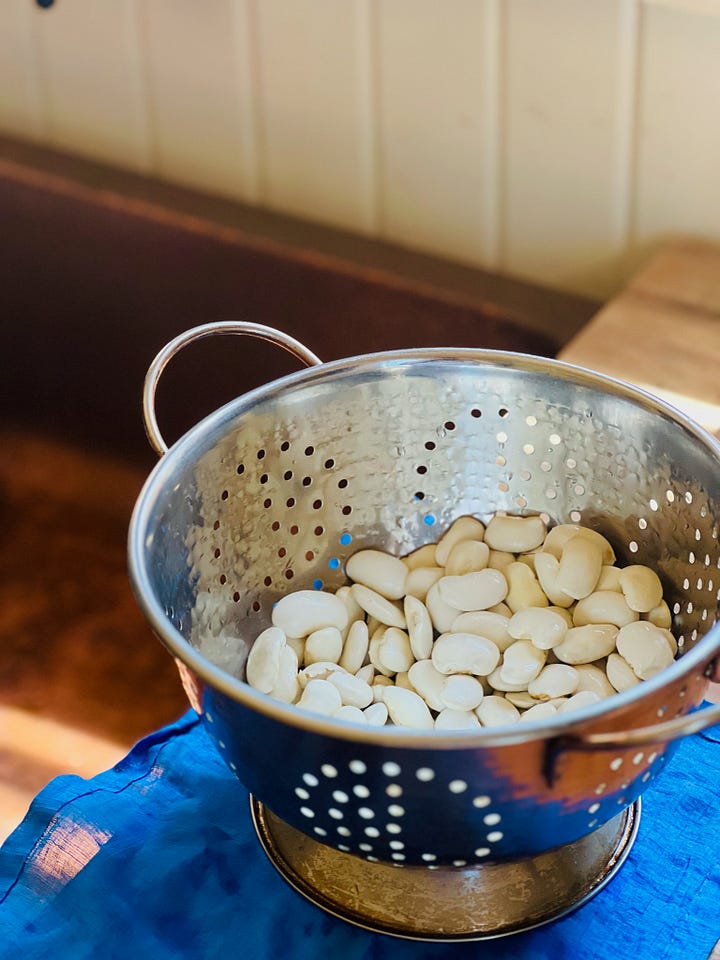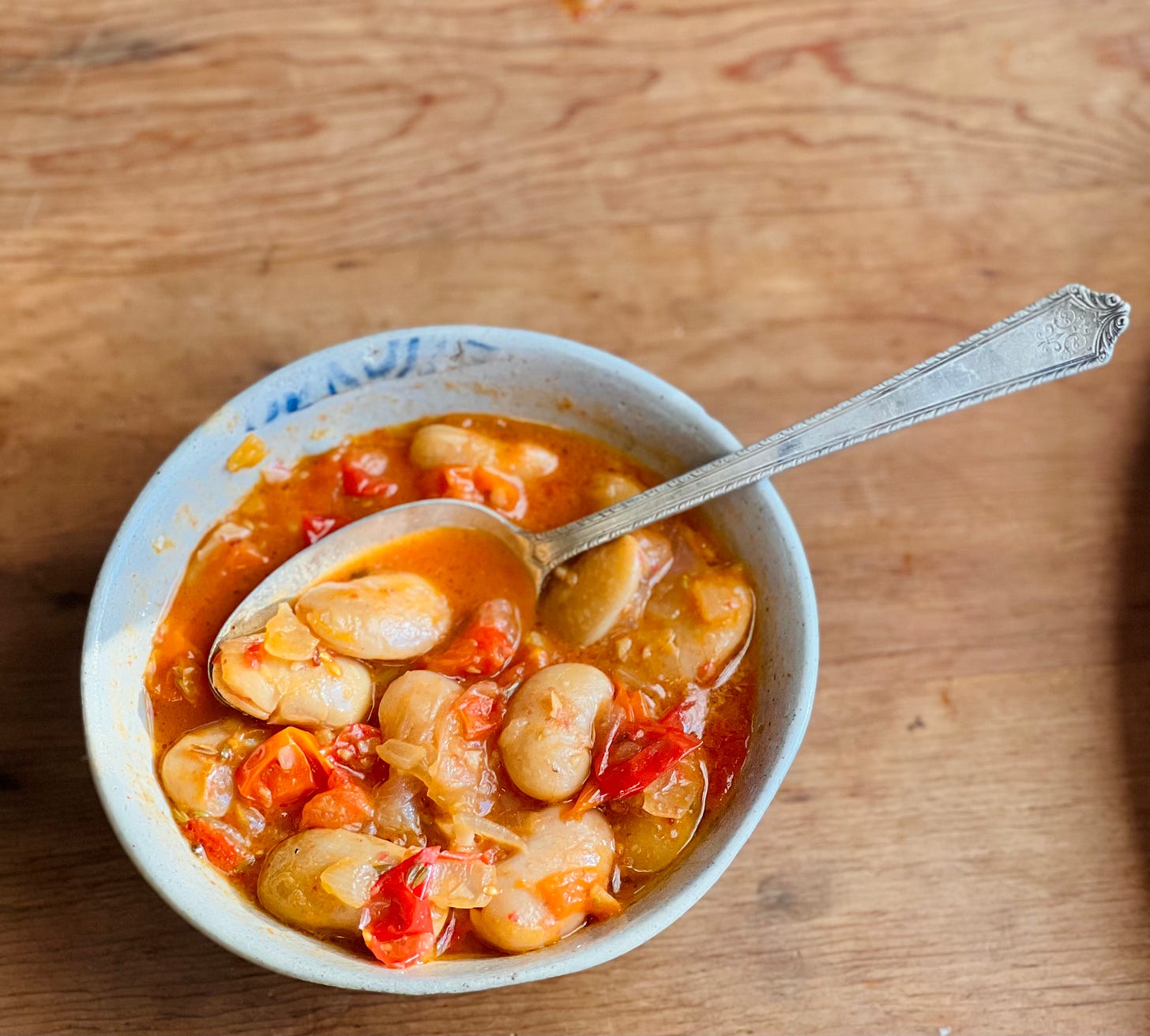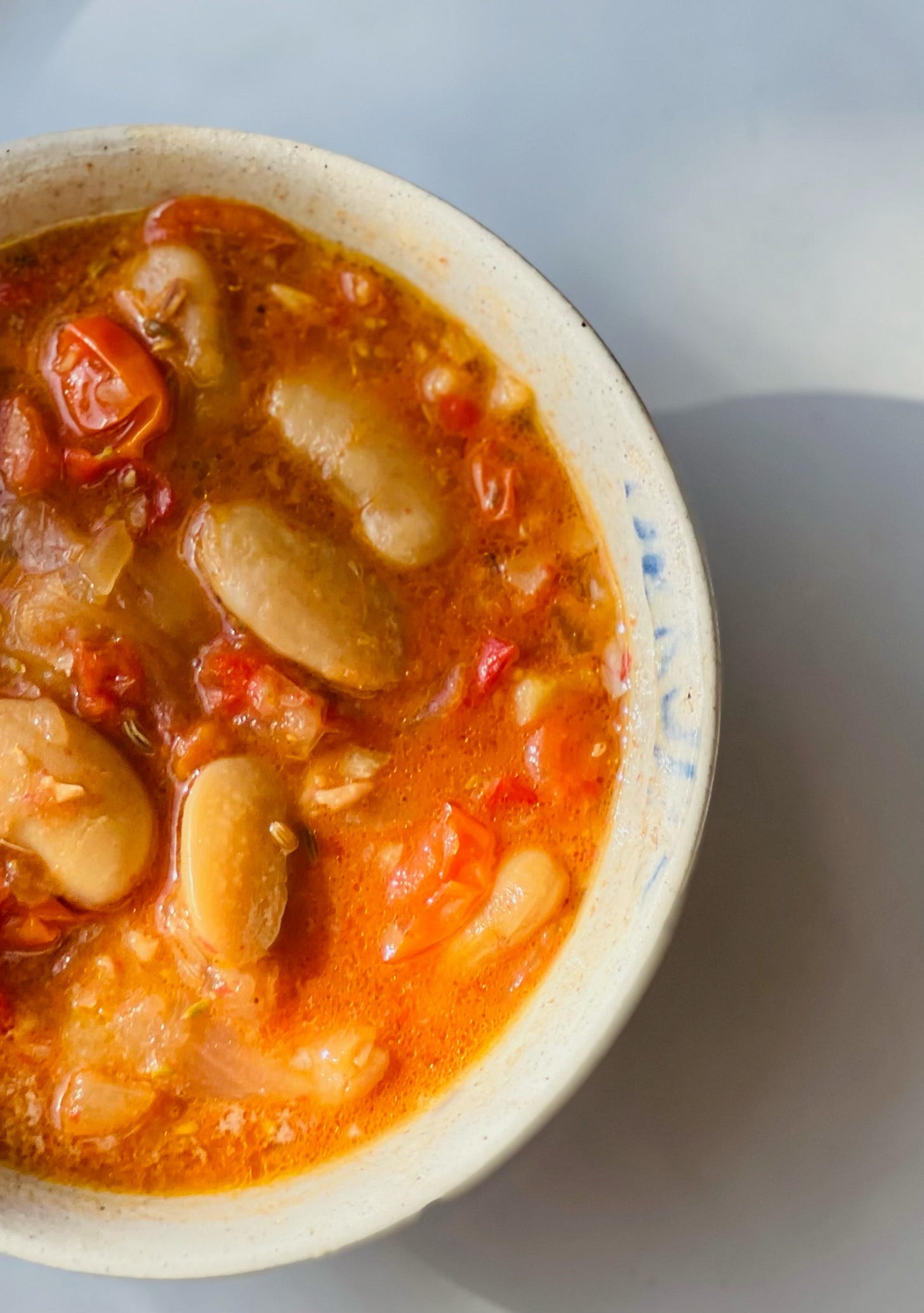On Becoming A Horse
The Fat Cap mystery and perfect Royal Corona beans
Early in the pandemic I’d taken to jumping on a small personal trampoline for exercise- my nightly rebounding (as the trampoline community refers to it) sessions became somewhat ritualistic: me in all black, a little tipsy, alone in the backyard, listening to the same three songs on repeat, at dusk for about 20-30 minutes. I’m not sure what kind of magic this ritual held, if any, but I noticed that the nightly practice brought on a meditative state where my mind was free to wander into little nooks and crannies producing untouched memories and strange observations.
On one of these tequila infused evenings, mid-bound, I found myself remembering a story I’d read(?) about a woman who turned into a horse. Or, more accurately, a woman who chose to give up her human body to become a horse. I could only recall a few loose details about the story itself:
The woman’s slow change from human to horse inspired both awe and repulsion, particularly when the hooves came in.
Her roommate, also undergoing transformation (pregnancy), stood alongside her, though most everyone else viewed it as a form of self destruction.
She ended up at some kind of horse camp in the end, where she could fully pursue her own wildness.
Apart from those particulars I had no idea who had written it or where I’d read this story. The New Yorker? Some indie lit mag? This was the exact kind of puzzler I needed to feed my late-night research binges. So, a little after midnight, I took to the interweb to figure it out and spoiler, I DID NOT FIND THE HORSE STORY, what did I find, you ask? Beastaility is alive and well on the front pages of google (alarming!!!) and stories about people turning equine are basically non-existent in the universe of fiction. After a few hours of nightmarish, traumatizing deep-diving, I felt a new fixation percolating: I had to re-read that story, it felt deeply important, like it was holding some kind of secret message or significance meant for me in that moment. I also needed to confirm that this wasn’t some fever-dream memory about a very weird story I had never actually read.
The search continued, in the much safer confines of publications’ archives, to no avail. I did find the wrong horse story deep in the recesses of yesteryear New Yorker articles; which at the time, seemed hysterical— hours of searching to find a story that was about a woman becoming a horse but not the right woman or the right horse.
Then it was late summer and we were having more friends over for distanced backyard dinners; I was going on about the great horse story mystery and how it was slowly ruining my life and my friend Shelly says, “I know that story!”
————— stunned silence—————
“you can’t find it because you didn’t read it, you listened to it on This American Life.” And just like that, the obsession that had taken up so much of my headspace and time just…evaporated.
I listened to it a few times that night, printed out the episode transcript, and hunted around for the secret meaning, which, most frustratingly, continued to elude me. But, right now, as I recount all of this, the message is quite clear: the story was heralding an unstoppable, uncomfortable transformation– the end of my 10-year relationship and marriage, new love, sudden parenthood, and a season of life wildly unrecognizable from the old.
Now hold all of this in your mind- the mystery, the possibilities of transformation and let me tell you about beans.
The perfectly cooked Corona bean was, until recently, the white whale of beans for me. I don’t believe in soaking my beans, the “it’s complicated” status should apply to life, not dinner. And at least a handful of people on the internet agree with me, insisting that gigantor beans, like Corona, do not require soaking to be creamy and uniform and perfect. But every time I made them, they’d end up cracked and broken (overcooked) or, somehow, both over and underdone at once. Lately though, with my bean confidence at an all-time high, I thought it might be time to try my hand at the Corona again. This time, using a fat cap.


The fat cap holds a similar lore and air of mystery as the horse story. At some point in the pandemic I was making my way through (all?) of the America’s Test Kitchen and Bon Appétit Youtube videos and someone made a pot of beans, using a lot of oil on top, and referred to it as “The Fat Cap.” I took the term and ran with it, asking all my friends if they were or were not fat-cappers. Trying it myself a few times, but not feeling convinced that the Pintos or Alubia Blancas or whatever smaller bean I was making could be improved upon by adding a $12 covering of oil to the pot. Still though, if you’d asked, I would have said I fuck with the fat cap, because partly it sounds cool, partly I’m not really sure what it does (calling all food scientists), and partly because oil is magical so a lot of oil seems like it would be a lot magical.
In starting this substack Megan and I have been talking about “The Fat Cap” again, wanting to write about it and properly cite it, we both went looking for its origins. Two people with prominent Gemini placements (research bitches unite) scoured the internet and couldn’t find the reference (as it pertains to beans). Fated to be another horse story? Maybe. The Fat Cap seems to be lost in the abyss somewhere.
It’s not a novel idea though, using a shit-ton of oil in the bean-making process, home and professional bean lovers are always going on about the importance of fat. But the idea of creating a 1-2-3 inch cap of oil over your simmering pot of beans, is more prescriptive.
My best guess about what the fat cap is actually doing is that the oil acts as a sort of lid on the beans, and when you’re cooking, especially with a particularly big bean, it helps keep all the heat and moisture in and the beans cook more evenly(?). So a couple weeks ago I put it to the test. I went out and bought a bottle of Kirkland olive oil with the express intent of using (potentially wasting) at least half the bottle on mastering the Corona bean once and for all. Long story long, it worked. I had perfectly intact creamy, salty, flavorful, almost confit-ed gigantic beans to eat and share and brag about to all my bean friends.
Hopefully someone here can solve this mystery as effortlessly as Shelly, until then, try fat-capping for yourself and revel in the wonder of deep transformation. If only becoming could always be this simple.
Perfect Coronas
1 bag of Royal Corona Beans, Rancho Gordo of course
1 Onion, yellow or white (peeled and quartered)
6 garlic cloves, partially smashed
1-2 cups oil, enough to cover the entire top of of the pot, creating a substantial cap of oil
Salt!
Optional Aromatics: 1 halved lemon (seeds removed), basil (on stem), fresh or dried oregano or other fresh herbs, red pepper flakes
Get a big, heavy, preferably cast iron enamel pot and put a glug or two of olive oil in the bottom (enough to cover).Heat should be on medium, or whatever your stove needs to heat without getting high enough to burn the oil
Wait for the oil to get hot and crack some black pepper and a (big) pinch of red pepper flakes into the oil, they should sizzle a bit and that’s how you know it’s hot enough to move on
Add your chosen aromatics now, flat side down: onion cut in quarters, lemon cut in half (seeds removed), garlic, herbs (this time I used a big sprig of rosemary, omitted the lemon and added a handful of cherry tomatoes to the pot)
Let simmer in oil for about 2 minutes, turning the onion to brown on both sides
Add your rinsed NOT PRE-SOAKED Royal Corona beans to the pot
Quickly add water to pot, enough to cover about 3 inches over the beans
Salt the water before adding your fat cap, taste and make sure it’s salty, not undersalted…just like soup-level salty, it’s a real goldilocks situation here
Add any more fresh or dried herbs if you’re feeling in the mood (make sure to reserve fresh herbs to finish before serving)
FAT CAP: let the EVOO flowwww! About 1-2 cups enough to really cover the top of your pot, and then maybe a little more. If you don’t feel like your bank account is emptying itself into the pot you’re probably not using enough
Bring to a hard boil for about 15 minutes
Drop down to a low simmer, with the lid askew, but on
Check beans and water level every 20 minutes, I always have to add more water, make sure you’re adding boiling water to the pot if you have to top it off
If you add more water, add more oil, because that’s what all the fat-cappers are doing
When the beans are perfectly magically soft and creamy and super delicious (probably 2-3 hours later), let them sit in the pot to rest, this somehow helps them to look super beautiful before you reheat to serve.
Then, do whatever you want: marinate them for an appetizer, serve on crostini, make a salad, make a side, put them in a bowl with a bit of herbs and lemon green sauce or pesto, make a soup, make some pizza beans or maybe just spoon them from pot to mouth and contemplate ways to cultivate your own wildness (sans horse hooves).




Further “Fat Cap” context: https://www.bonappetit.com/story/brothy-butter-beans
In his email the chef writes: “I like to have an inch or so fat cap on the top to keep the beans submerged”
Yum!